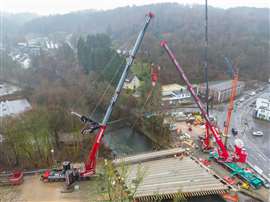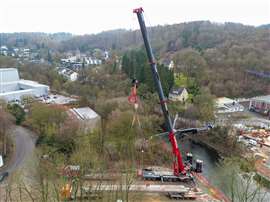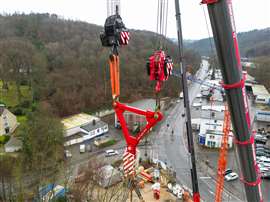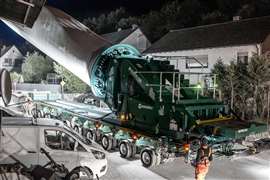Read this article in Français Deutsch Italiano Português Español
Cranes lifting together at height
30 January 2024
 In the swing of it: The eighth and last 32 metre long bridge beam is lowered into place using the two cranes together. Photo: Liebherr
In the swing of it: The eighth and last 32 metre long bridge beam is lowered into place using the two cranes together. Photo: Liebherr
An unusual rigging and lifting arrangement characterised some tandem lifting work to install a new road bridge over a river in Germany.
The two large wheeled mobile telescopic cranes were hooked close together high in the air instead of one at each end of the bridge beams.
Deterioration to the structure of the Hammesberg Wupper river bridge in Wuppertal Heckinghausen, Germany, initially caused implementation of temporary restrictions. Only vehicles below 30 tonnes travelling at no more than 30 km/h could cross the bridge. This couldn’t continue for long which meant the old bridge, built in 1965, had to be replaced.
Traffic disruption caused by the bridge being out of action had to be kept to a minimum. Installing a new one as quickly as possible meant making it out of precast concrete elements. Additional preparatory work prior to the old bridge’s demolition included completion of new bored piles and installation of new power lines across the river.
With the old bridge now dismantled it was time for its replacement. Available space was insufficient for one large heavy crane to build the new bridge. Instead, a pair of large wheeled mobile cranes, lifting in tandem, was used for the job. A 700 tonne capacity Liebherr LTM 1650-8.1 was brought in from Autokrane Schares and a 450 tonne LTM 1450-8.1 was deployed from Dornseiff Autokrane and Schwertransporte.
 Lifting the 85 tonne bridge beams from the delivery vehicle low loader using the 700 tonne capacity LTM 1650-8.1 wheeled mobile telescopic boom crane. Photo: Liebherr
Lifting the 85 tonne bridge beams from the delivery vehicle low loader using the 700 tonne capacity LTM 1650-8.1 wheeled mobile telescopic boom crane. Photo: Liebherr
Setting them up
The cranes were erected one on each bank of the River Wupper, lined up centrally just outside the bridge’s abutments. From there they shared the lifting of eight precast concrete elements each weighing 85 tonnes.
On delivery of the concrete elements the larger of the two cranes, the LTM 1650-8.1, lifted them from the low loader trailers as far across the river as it could manage. At that point the LTM 1450-8.1 on the other side of the river lent a hand. Following an unconventional approach working high above the ground out of a safety cage suspended from a third crane, technicians attached the hook of the 450 tonne crane to a special triangular cross beam rigging arrangement.
Eric Reichmann, Schares project manager, explained the size and capacity issue, “Even the 800 tonne LTM 1750-9.1 wouldn’t have been able to install the girders on its own. Furthermore, the transport vehicle would not have been able to drive alongside the crane. There was simply not enough space. So we had to use both banks of the river.”
Clever rigging
 One of those simple but brilliant ideas. The gross load of the reinforced concrete girders including hook blocks and triangular cross beam was 95 tonnes. Depending on the radius, the LTM 1650-8.1 lifted 60 to 95 tonnes, while the LTM 1450-8.1 was required to lift 24 to 57 tonnes. Photo: Liebherr
One of those simple but brilliant ideas. The gross load of the reinforced concrete girders including hook blocks and triangular cross beam was 95 tonnes. Depending on the radius, the LTM 1650-8.1 lifted 60 to 95 tonnes, while the LTM 1450-8.1 was required to lift 24 to 57 tonnes. Photo: Liebherr
The tandem lift solution required a 160 tonne capacity triangular cross beam and an additional mobile crane with a safety cage. “For this, we utilised our LTM 1100-4.1 with emergency take down system. When attaching the hook on the lifting gear below the triangular cross beam, different cable lengths were used to achieve a slight inclination of the concrete beams for installation on the slightly divergent abutment heights,” Reichmann continued.
Each load’s total weight came in at 95 tonnes, comprising the 85 tonne beam, hook blocks and the triangular cross beam lifting frame. This was split according to radius between 60 and 95 tonnes on the larger crane and 24 to 57 tonnes on the smaller one.
Over a period of two days the two cranes lifted and placed eight reinforced concrete bridge beams, each 32 metres long, across the river.
The new bridge is due to reopen by the end of March, once again allowing users of the L420 road to avoid having to make a 3 km detour.
STAY CONNECTED


Receive the information you need when you need it through our world-leading magazines, newsletters and daily briefings.
CONNECT WITH THE TEAM












